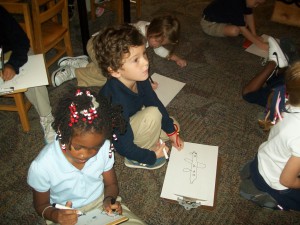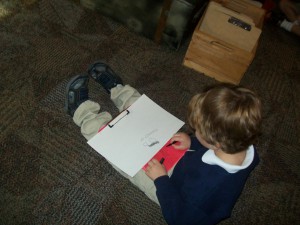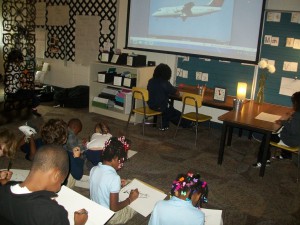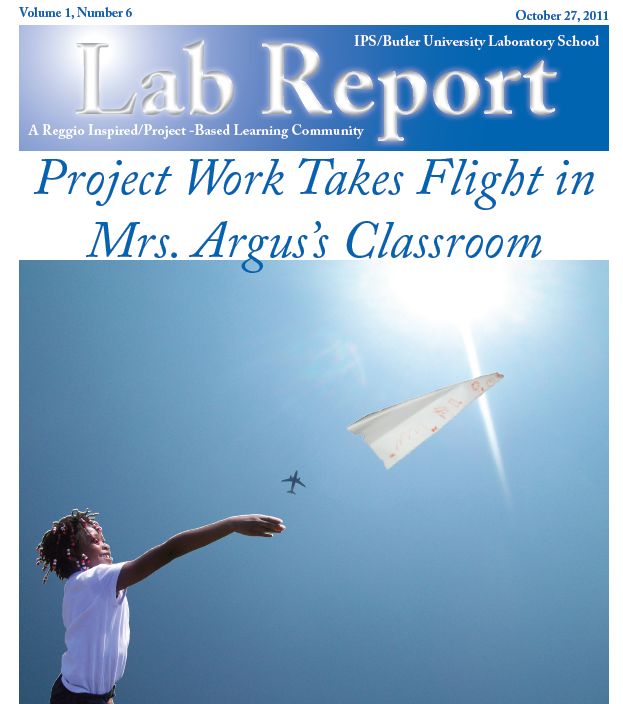Sep
12
2011

Mrs. Argus
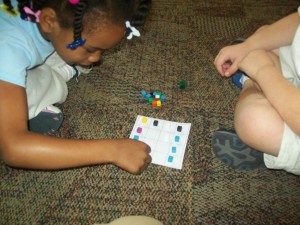
Kaitlyn and Aidan counting how many spots are left.
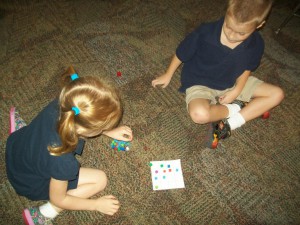
- Lucas and Regan playing Cover All.
Recently, the kids were introduced to a new math game, Cover All. They take turns with a partner rolling a dice and adding that many cubes to their game mat. The last person to cover the last square is the winner. We have been practicing taking turns, being gracious winners and losers, and practicing counting and one to one correspondence. Today while playing, I noticed Kaitlyn and Aidan were counting something but it wasn’t their cubes. I asked Kaitlyn what they were counting. “All the spots that are left! One, two, three, four, five, six seven!” Kaitlyn was counting the squares on the game board to see how many were left for their cubes. I asked the kids, “What do you suppose will happen when we roll the dice again and add the cubes?” Each child had a different response- one thought more spaces would appear, one thought less. Aidan rolled the dice and added two cubes. We then counted the remaining spaces. “There are less!” Aidan said. We talked about how although we were adding cubes, the game was also similar to subtraction because the spaces on the board were becoming fewer and fewer. It leaves me asking myself a question, is this game more like addition or subtraction?
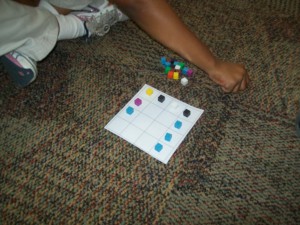
Sep
10
2011

Mrs. Argus
Our class has started a new initiative called Positive Points. Each time our class is doing something positive together as a class (being respectful to who is listening, being peaceful at lunch, filling each other’s buckets) we can earn a positive point. We have been practicing making tallys to represent the points and counting them each time a point is added. Last week, our positive point goal was to reach 25 points, and we achieved that goal. As a reward, we watched the movie Chicken Run which is about chickens building an airplane. This week, we started a new goal, 30 points, and today we talked about what should happen when we achieve our goal. We wrote a list of ideas as a class, ranging from having a Ramen Noodle party (who knew there could be such a unique party?) to baking and enjoying cookies as a class. We chose four ideas and voted on our favorite- Making our Own Ice Cream! I ancicipate we will achieve this goal in the upcoming week and will most likely do this on Friday. If any parents or adult helpers are interested in helping out with this experience, please let me know!
Also, on Friday afternoon I sent home a conference schedule for parent teacher conferenes. These are on September 21st. They will be from 12-7pm in twenty increment time slots. Please indicate on the paper sent home or via email several slots that would work for you. I will then contact you to confirm what time works best.
I also sent home a birthday calendar. At the Lab School, we will be addressing birthdays by celebrating them at the end of each month. If it is your child’s birthday month, they will have the oppurtunity to bake cupcakes at school for their classmates. We will always need volunteers for this, so please look at the schedule and consider helping.
Sep
08
2011

Mrs. Argus
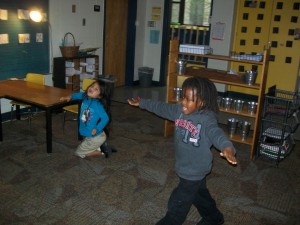
Our friend Zacharyah walking like an airplane.
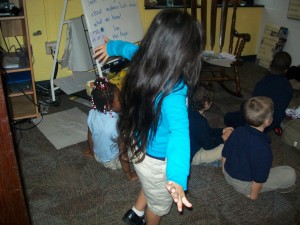
- Landing gear down and flaps up!
We have begun talking about different parts of an airplane and what they do. We watched a great video online that had an interactive game at http://www.avkids.com/hangar/smartparts/ . After watching the interactive video and game, we tried acting out some of the plane parts with our bodies. Our pictures today are two friends who tried walking to their seat with their arms out like wings and then tilted their flap to “break” when they saw their seat. The kids also had a chance to try the game on their own during arrival and explore. We decided that we wanted to share our new airplane part knowledge with others who may be interested and discussed writing a class book on airplanes. We voted on our title, How to Fly an Airplane, and have begun writing together. Each page is about a different part of an airplane and what it contributes to flight. So far we have a page for wing flaps, wings, the rudder, and landing gear. We are learning so much and the kids still seem so interested in flight- I wonder if we have any future pilots in our classroom.
Sep
07
2011

Mrs. Argus
One of the things that our class wants to know about airplanes is how they fly. One of the ways we can better understand how they fly is by understanding their parts and their functions. To begin this task, we did an observational drawing of an airplane. I projected a large picture of a jet on our screen and asked the children to sit quietly in a comfortable drawing spot and draw exactly what they saw. We talked about noticing the details of the picture- the shading, the small words on the plane, the placement of windows. After we were done, we talked about what parts we had added to our planes and what we supposed each part did. We also took time to admire each friend’s drawing-we really enjoyed seeing how different each friend’s interpretation was of the same picture. We talked about how we have many similarities but we can also have very different perspectives on topics we discuss so it is important to listen and share everyone’s ideas. Our observational drawings are proudly displayed outside our classroom. Come and see them!
In Writer’s Workshop,we have been talking a lot about details in our pictures. Last week, we talked about faces and bodies of our characters and how we can add detail to them to show how they are feeling and what they are doing. This week, we are learning about adding detail to our stories by adding a setting, or background. Coincidentally, I had an experience this weekend that had to do with setting and shared it with our class. Over the weekend, my beloved dog Jackson ran away. He was gone for about 15 hours, and then my husband and I got a phone call that he was in the neighborhood in someones yard. While I am so relieved to have him back, I can’t help but wonder what Jackson did all that time he was missing and where he visited in the time he was gone! We decided to write a class book about where Jackson could have been in those 15 hours he was gone. Each child created a page that illustrated Jackson in a place he may have visited (the setting!) and focused on adding lots of detail to clearly show the location. Some of the pictures were quite humorous (the beach, Wal-Mart, school) and some were rather realistic (the pound!). While I can’t say I am glad that Jackson went missing this weekend, I will say that it provided a fun and authentic reason to talk about setting. I just hope Jackson doesn’t give us a reason to do this lesson again!
Sep
06
2011

Mrs. Argus
We have a time each day for Reader’s Workshop. During this time, I read a story and present a mini lesson that has to with with a concept or technique associated with reading. It may be on making predictions, decoding (sounding out words), or a variety of other reading skills. One of our big focuses this week is looking at letters when we are reading to see what the author is trying to say. One of the skills I teach the kids is Tucker Signing. While this is not the only way that we present phonics at the lab school, it is one great tool to help develop letter-sound association in both reading and writing. The concept of Tucker Signing is that each letter has a sound and movement to go with it. By teaching letters in this way, chldren are given three ways to remember the letter- visual (by looking at it), auditory (by hearing and creating the sound), and kinesthetically (by making a movement that is associated with the letter and sound). Tucker Signing is not only useful for individual letters, but also for digraphs (a pair of letters that creates one sound) which is something many of our more advanced readers are working on. Ask your child If they can show you the “sign” and sound for some of their letters. You may be suprised at what you learn!
The following is a link to the Tucker Signs website should you want to find out a little more information about this strategy.
http://www.tuckersigns.com/parents.html






